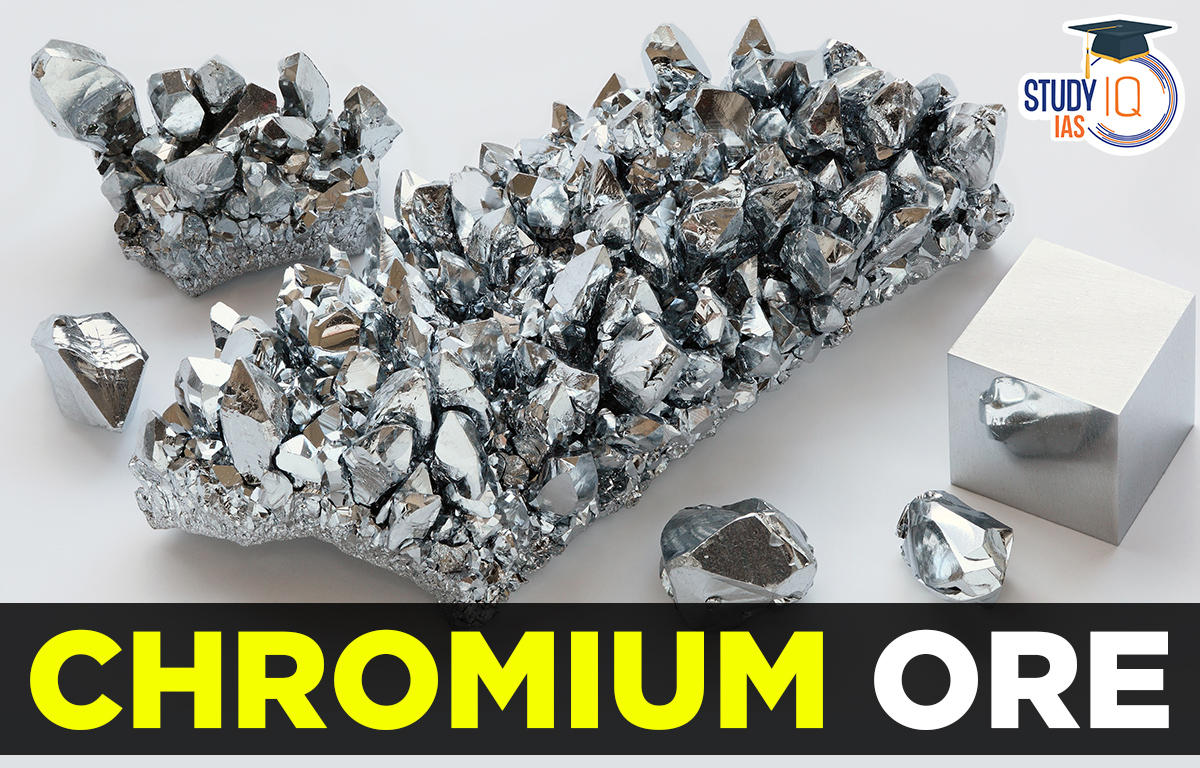Table of Contents
Chromium Ore
Chromium is a critical alloying metal. It is used in the production of alloys with other metals such as nickel, cobalt, copper, and others, as well as in many other metallurgical, refractory, and chemical industries. Chromium increases the strength, hardness, and toughness of its alloys.
Chromite (Cr) is the only commercially viable chromium ore, also known chemically as iron chromium oxide. It is a steel-grey, lustrous, hard, and brittle metal with a high melting point that takes a high polish and resists tarnishing. Resistance to corrosion, oxidation and wear are the properties of chromium that make it so versatile and indispensable.
Read about: Iron Ore
Chromite Ore Distribution in India
India’s chromite reserves are estimated to be 203 MT. Odisha has more than 93 per cent of the resources (Sukinda valley in Cuttack and Jajapur). Manipur, Nagaland, Karnataka, Jharkhand, Maharashtra, Tamil Nadu, and Andhra Pradesh have minor deposits. Odisha is the sole producer of Chromite Ore (around 99 per cent). More than 85% of the ore is of high quality (Keonjhar, Cuttack, and Dhenkanal).
Karnataka is the state with the second-highest production. The main production comes from the districts of Mysore and Hassan. Other producers include Andhra Pradesh’s Krishna district and Manipur’s Tamenglong and Ukhrul districts.

Read More: Manganese Ore
Chromite Distribution in World
The mineral chromite is the primary source of chromium. South Africa, Kazakhstan, India, Albania, and Turkey are among the countries that mine it. Here is the map of Chromite Distribution in the World attached below:

Read More: Cobalt Ore
Chromium Ore Properties
Chromium ore is a naturally occurring mineral that contains the metal chromium. It is typically found in mineral deposits, including ultramafic rocks and other chromite-rich seams. The ore is processed to produce metallic chromium, which is then used in various applications, including stainless steel production, chromium plating, and as an alloying element in cast iron and steel.
Chromium is a gleaming, brittle, and hard metal. It has a silver-grey colour and can be highly polished. It does not tarnish in the air, but when heated, it gives birth to and forms green chromic oxide. Because chromium is unstable in oxygen, it forms an impermeable oxide layer that protects the metal beneath.
Read about: Energy Resources
Chromium Ore Uses
Chromium ore is processed to produce metallic chromium, which is then used in various applications, including:
- Chromium is a key component in the production of stainless steel, contributing to its strength and resistance to corrosion.
- Chromium is used for electroplating to provide a hard, durable, and corrosion-resistant coating for metal objects.
- Chromium is added as an alloying element in the production of cast iron and steel to enhance their strength and toughness.
- Chromium is used in the leather tanning process to produce strong and durable leather goods.
- Chromium compounds are used as pigments in various industries, including paint, ceramics, and plastics.
- Chromium is used as a catalyst in the production of chemicals and in the refining of petroleum.
- Chromium is used to produce refractory materials, which are used in high-temperature applications such as furnace linings.
In summary, chromium ore is a valuable resource for various industries due to its unique properties, including its strength, durability, and resistance to corrosion.
Read More: Types of Resources
Chromium Ore UPSC
Chromite ore (also known as chrome ore) is used in the metallurgical industry to make chromium ferroalloys and metals. It is also used in the chemical industry to produce sodium dichromate, which is a chemical industry product as well as an intermediate product used in the production of other chromium chemicals.


 Indian Sex Ratio 2024 State-wise, NFHS-5...
Indian Sex Ratio 2024 State-wise, NFHS-5...
 Union Territories of India with Capital ...
Union Territories of India with Capital ...
 Rowlatt Act 1919, Meaning, Provisions, R...
Rowlatt Act 1919, Meaning, Provisions, R...

















